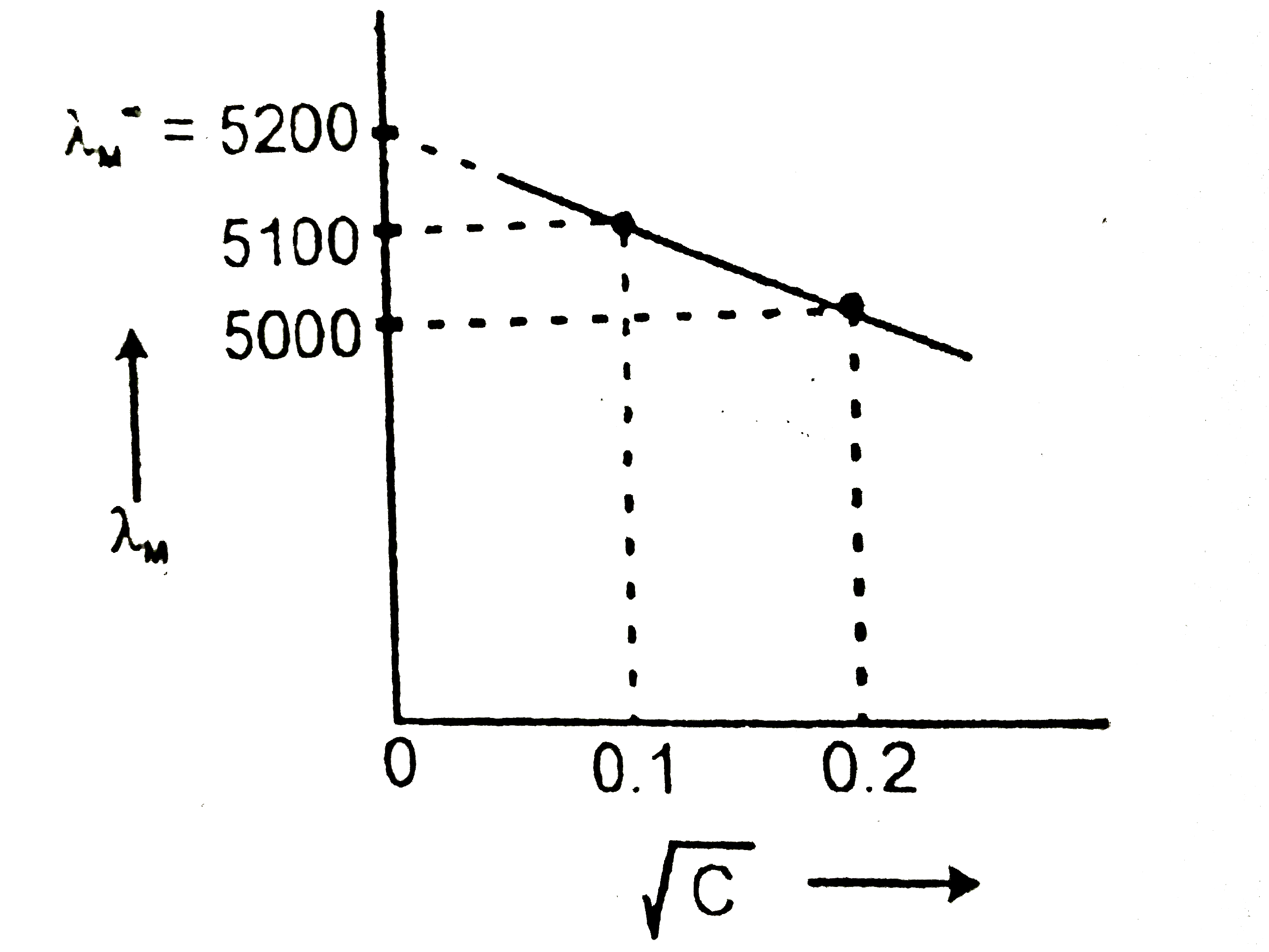Express mathematically the relationship among the degree of dissociation of an electrolyte and its molar conductance.
To express mathematically the relationship among the degree of dissociation of an electrolyte and its molar conductance, we can follow these steps:
Step 1: Define the Terms
- Degree of Dissociation (α): This is the fraction of the total number of moles of the electrolyte that dissociates into ions in solution. It is represented by the symbol α (alpha).
- Molar Conductance (λ): This is a measure of how well an electrolyte conducts electricity in solution. It is represented by λ (lambda).
- Molar Conductance at Concentration C (λ_M): This is the molar conductance of the electrolyte at a specific concentration C.
- Molar Conductance at Infinite Dilution (λ_M∞): This is the molar conductance of the electrolyte when it is diluted infinitely, meaning that the ions are far apart and do not interact with each other.
Step 2: Establish the Relationship
The mathematical relationship between the degree of dissociation and molar conductance can be expressed as:
α=λMλM∞
Where:
- α is the degree of dissociation.
- λ_M is the molar conductance at concentration C.
- λ_M∞ is the molar conductance at infinite dilution.
Step 3: Explanation of the Relationship
- The numerator (λ_M) represents the molar conductance of the electrolyte at a particular concentration, indicating how much the electrolyte can conduct electricity at that concentration.
- The denominator (λ_M∞) represents the maximum possible molar conductance when the electrolyte is infinitely diluted, which reflects the intrinsic ability of the ions to conduct electricity without any interactions that occur at higher concentrations.
- Therefore, the ratio gives us the degree of dissociation, indicating what fraction of the electrolyte has dissociated into ions at concentration C compared to its maximum potential at infinite dilution.
Final Expression
Thus, the final expression relating the degree of dissociation of an electrolyte to its molar conductance is:
α=λMλM∞
- Degree of Dissociation (α): This is the fraction of the total number of moles of the electrolyte that dissociates into ions in solution. It is represented by the symbol α (alpha).
- Molar Conductance (λ): This is a measure of how well an electrolyte conducts electricity in solution. It is represented by λ (lambda).
- Molar Conductance at Concentration C (λ_M): This is the molar conductance of the electrolyte at a specific concentration C.
- Molar Conductance at Infinite Dilution (λ_M∞): This is the molar conductance of the electrolyte when it is diluted infinitely, meaning that the ions are far apart and do not interact with each other.
The mathematical relationship between the degree of dissociation and molar conductance can be expressed as:
- α is the degree of dissociation.
- λ_M is the molar conductance at concentration C.
- λ_M∞ is the molar conductance at infinite dilution.
- The numerator (λ_M) represents the molar conductance of the electrolyte at a particular concentration, indicating how much the electrolyte can conduct electricity at that concentration.
- The denominator (λ_M∞) represents the maximum possible molar conductance when the electrolyte is infinitely diluted, which reflects the intrinsic ability of the ions to conduct electricity without any interactions that occur at higher concentrations.
- Therefore, the ratio gives us the degree of dissociation, indicating what fraction of the electrolyte has dissociated into ions at concentration C compared to its maximum potential at infinite dilution.
Thus, the final expression relating the degree of dissociation of an electrolyte to its molar conductance is:
Topper's Solved these Questions
- ELECTROCHEMISTRYBOOK - ICSECHAPTER - ELECTROCHEMISTRYEXERCISE - EXERCISE (PART-II Descriptive Questions)(SHORT ANSWER QUESTIONS)
38 Videos
- ELECTROCHEMISTRYBOOK - ICSECHAPTER - ELECTROCHEMISTRYEXERCISE - EXERCISE (PART-II Descriptive Questions)(LONG ANSWER QUESTIONS)
33 Videos
- ELECTROCHEMISTRYBOOK - ICSECHAPTER - ELECTROCHEMISTRYEXERCISE - EXERCISE (PART-I Objective Questions) (Choose the correct alternative)
25 Videos
- DISTINCTION BETWEEN PAIRS OF COMPOUNDS BOOK - ICSECHAPTER - DISTINCTION BETWEEN PAIRS OF COMPOUNDS EXERCISE - QUESTIONS
155 Videos
- GENERAL PRINCIPLES AND PROCESSES OF ISOLATION OF ELEMENTS BOOK - ICSECHAPTER - GENERAL PRINCIPLES AND PROCESSES OF ISOLATION OF ELEMENTS EXERCISE - EXERCISE (PART-I ( OBJECTIVE QUESTIONS )) (Fill in the blanks)
60 Videos
Similar Questions
Express mathematically relationship among the resistance (R ), specific conductivity and cell constant.
View SolutionFor the weak electrolyte , their degree of dissociation increase
View SolutionElectrolytes when dissolved in water dissociate into their constituent ions. The degree of dissociation of an electrolyte increases with
View SolutionThe molar conductivity of strong electrolyte
View SolutionThe equivalent conductivity of 0.1M weak acid is 100 times less than that at infinite dilution. The degree of dissociation of weak electrolyte at 0.1M is.
View Solution
At 0.04 M concentration the molar conductivity of a solution of a electrolyte is 5000Ω−1cm2mol−1 while at 0.01 M concentration the value is 5100Ω−1cm2mol−1 making necessary assumption (taking it as strong electrolyte) find the molar conductivity at infinite dilution and also determine the degree of dissociation of strong electrolyte at 0.04M.
View SolutionHow can Kohlrausch's law of independent migration can be applied for calculating the degree of dissociation (α) of weak electrolytes ?
View SolutionCalculate the percentage degree of dissociation of an electrolyte XY2 (Normal molar mass =164) in water if the observed molar mass by measuring elevation in boiling point is 65.6:
View SolutionMark out the correct statement(s) regarding electrolytic molar conductivity.
View SolutionCalculate the apparent degree of ionisation of an electrolyte MX2 in water, if the observed molar mass of the solute by measuring elevation in boiling point is 65.6 (Normal molar mass of the solute = 164).
View Solution
